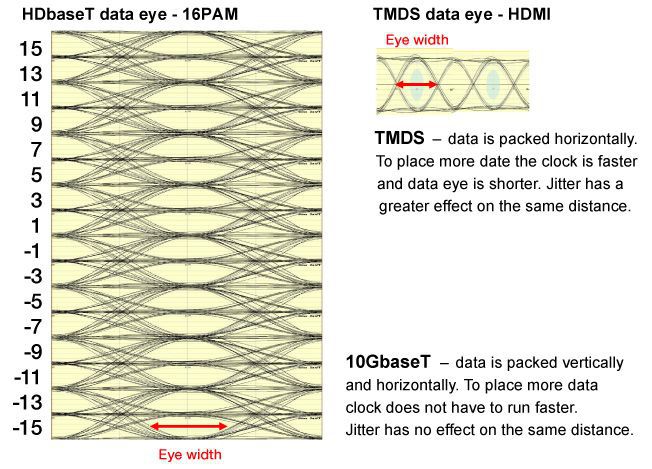-
Products
+
-
Products
- New Products
- AV over IP Solutions
- Unified Communication & Collaboration Solutions
- Digital Video Processing Solutions
- Control Systems & Software
- Matrix Switchers
- HDMI Switchers
- HDMI Distribution Amplifiers
- Wireless AV Solutions
- HDMI over CAT6 Extenders
- HDMI Fixers & Boosters
- HDMI Cables
- Active Optical HDMI Fiber Cables
- Audio Solutions
- Accessories
-
Key Digital AV Over IP Systems
- AV Over IP Systems Overview
- AV Over IP Products
- DIY AV Over IP Systems
- Control Apps and Software
-
-
Markets & Solutions
+
- KD University
-
Resources
+
-
Press Resources
- Press Releases
- Key Digital in the News
- Hires Artwork
-
Sales Resources
- Market Case Studies
- Video Resources
- Sales & Tech Presentations
-
- About Us +
- Contact
HDBaseT® Technology
By Mike Tsinberg - September 2016
 HDBaseT® is a new technology available for HDMI connectivity which enables the use of twisted pair wires to a greater extent than all previously used methods.
HDBaseT® is a new technology available for HDMI connectivity which enables the use of twisted pair wires to a greater extent than all previously used methods.
It is a direct result of a matured Ethernet connectivity technology called 10GbaseT. The basic advantage of HDBaseT is to utilize a more advanced method of data modulation compared to the TMDS method currently used in HDMI cables as well as some CAT5/6 extenders. TMDS is a basic bi-level data modulation method which allows transmission of "1" and "0" by simply sending High Level voltage as "1" and Low level voltage as "0". TMDS is a one dimensional method in that it sends information in only one dimension: Time. To increase data throughput using TMDS you simply need to increase the speed or clock by sending more "1's" and "0's" through the same time interval. The 10GbaseT, and subsequently, HDBaseT methods utilize a much more advanced 16PAM modulation method:
Figure 1:

16PAM stands for 16 Level Pulse Amplitude Modulation. The 16PAM method utilizes a two-dimensional data transmission process by encoding information both via Time and Amplitude. For example each symbol in HDBaseT can have 31 different amplitude values between -15 and +15. The speed of these symbols transmission can also be changed by changing clock. Such a two-dimensional method allows greater data capacity through the same speed (clock) channel. An increase in data capacity can be used in two ways:
- Increase data throughput without speeding up the clock OR
- Maintain the same data transmission but slow down the clock
- Or a combination of 1. And 2.
Slowing down the clock translates to a longer duration for the data eye to remain open, therefore providing less data jitter on payload data. A reduction in these jitter effects translates to longer connectivity distances since the data eye remains open at farther distances:
Figure 2:

Sending HDMI 1080p video at 60Hz and 12 bit Deep Color through the best TMDS-based extenders is limited to a distance of 150 feet while HDBaseT type extenders can go as far as 300 feet or more depending on the type of CAT5/6 cabling used.
Due to the tremendous data capacity of 16PAM when compared to TMDS, there is substantial increase in both distance and data throughput utilization.
HDMI connectivity also puts other constraints on the payload data when compared to regular Ethernet connectivity – the most important of these is an error free connection. In a 10GbaseT Ethernet packetized system, one or more packets can be lost during transmission. The receiving computer can simply submit a request to resend the lost data often without any noticeable changes to the user.
In HDMI systems the decoder cannot submit a request for lost data packets to be resent. Each of the packets is displayed on the video screen in real time. Consequently, a loss of the packet will show as a dropped part of the picture frame or a complete loss of the picture frame(s). In order to 'protect' the video, audio, and other data transmissions, HDBaseT utilizes a special forward error method providing Dynamic Multi-Level 16PAM+ Modulation with multiple, per data type, bit-rate/error-resistance tradeoffs for various data types. This method ensures picture and sound integrity when approaching the usual data "cliff" effect in twisted pair HDMI connectivity.
One of the HDBaseT extender implementation types such as KD-CATHD500Tx/Rx block diagram is shown in Figure 3 below:
Figure 3:

In this scenario we took full advantage of the available data capacity and robust nature of the HDBaseT system. In addition to complete 1080p 60 Hz 12 bit video, Dolby-True HD, and DTS-HD audio, this system connects bi-directional RS-232 at speeds of 115200 baud, true bi-directional IR, HDMI CEC and 100 Mb/s Ethernet. We also added important features such as EDID control (EDID can be native or from a selection of 10 EDIDs from our library) and HDMI pass-through, ensuring that the HDMI signal is available locally at the Tx unit while transmitting a signal over a long distance to the Rx unit via CAT5/6. We developed a special CAT6STP cable – KD-CAT6STP1X - for this extender that on average provides a 30% increase in signal distance compared to a standard CAT6STP cable. For example, a 1080p signal can now reach distances of 400 feet versus a standard 300 feet and a 1080i/1080p24/720p signal can reach up to 600 feet compared to 450 feet for a standard CAT6STP cable.
Learn More About HDBT Products
Discover Key Digital HDBaseT Products.







